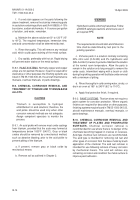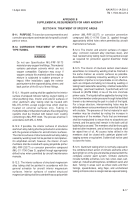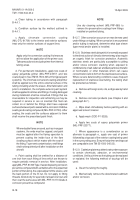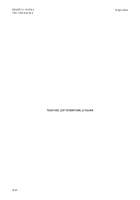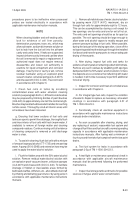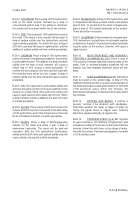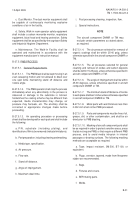TM-1-1500-344-23-2 - Page 225 of 240
B-23
NAVAIR 01-1A-509-2
TM 1-1500-344-23-2
15 April 2009
procedures prove to be ineffective when processed
probes are tested electrically in accordance with
applicable maintenance instruction manuals.
NOTE
When cleaning bladder and self-sealing cells,
look for evidence of cell liner porosity,
deterioration, punctures, tears, etc., which may
allow salt water, sodium dichromate solution or
fuel to leak from the fuel cell into the airframe
cavity and cavity liners. If leaks are suspected,
inspect airframe cavity liners and cavities when
the cell is removed for repair or replacement. If
authorized repair does not require removal,
disassemble and loosen cell sufficiently to
examine for liquid entrapment and corrosion
damage. If cavity liner or cavity is wet, remove
residual fuel/water using an explosion-proof
vacuum cleaner, cellulose sponges (A-A-2073),
and cheesecloth (CCC-C-440). Treat corrosion
in accordance with Chapter 6.
f. Clean fuel cells or tanks by scrubbing
contaminated areas with water emulsion cleaning
solution (see paragraph B-20.c.). Efficient scrub brushes
may be prepared by trimming bristles of paint brushes
(H-B-420) to approximately one half the normal length.
Brushes may be attached to wooden handles for reaching
remote areas. Thoroughly scrub all interior areas until
all residues have been loosened.
g. Ensuring that lower sections of fuel cells and
tanks are open to permit free drainage, thoroughly flush
and rinse interior of fuel cells with fresh (warm water, if
available) to remove all foreign matter and cleaning
compound residues. Continue rinsing until all evidence
of cleaning compound is removed or until discharge
water is clear.
h. To assist in cleaning, flush fuel cells with a mixture
of one part isopropyl alcohol (TT-I-735) and one part tap
water. A pump (5100-254B) and extension hose may be
used to apply the water/alcohol solution.
i. Flush the hidden area with the 50% water/alcohol
solution. Remove residual water/alcohol solution with
an explosion-proof vacuum cleaner, cellulose sponges
(A-A-2073) and cheesecloth (CCC-C-440). To facilitate
drainage of hidden or inaccessible areas formed by
bulkheads, baffles, stiffeners, etc., alter attitude of aircraft
by inflating and deflating gear struts or by using jacks in
accordance with applicable maintenance instructions
manuals.
j. Remove all visible traces of water: alcohol solution
by passing warm (120
°
F (49
°
C) maximum), dry air
through fuel cells for approximately eight to 12 hours.
This can be accomplished by closing a cell except for
two openings: one for entry and one for exit of hot air.
The entry and exit openings should be as far apart as
possible. The exit opening should be large enough to
allow water and alcohol vapors to readily escape and
prevent pressure buildup in fuel cells. When possible,
during the last part of the drying operation, close off the
exit opening and direct the drying air through the installed
fuel boost and transfer pump ports to ensure adequate
drying of these parts.
k. After drying, inspect fuel cells and tanks for
evidence of salt crystals or remaining sodium dichromate.
Remove any such residues by swabbing with sponges
dampened with the 50% water: alcohol solution. Unless
the deposits are so extensive that reflushing with water
is needed, it will not be necessary to perform additional
forced air drying.
l. Inspect for corrosion and treat all corroded areas
in accordance with Chapter 6.
m. For integral type fuel cells, inspect the condition
of sealants. Repair or replace, as necessary, all sealant
coatings in accordance with paragraph 2-5f of
TM 1-1500-204-23-3.
n. Functionally check all electrical equipment in
accordance with applicable maintenance instructions
manuals before installation.
o. As soon as possible after cleaning, drying, and
any replacing of sealant, reassemble fuel system and
change all fuel filters and fuel aircraft to normal operating
capacity in accordance with applicable maintenance
instructions manuals. After fueling wait a minimum of
four hours and then take fuel samples from the low point
drains.
p. Test fuel system for leaks in accordance with
paragraph 2-5g of TM 1-1500-204-23-3.
q. A test flight or maintenance operational check in
accordance with applicable aircraft maintenance
manuals shall be performed following the performed
maintenance.
r. Inspect fuel storage tanks and trucks for possible
sources of fungus and/or water contamination.
Back to Top


